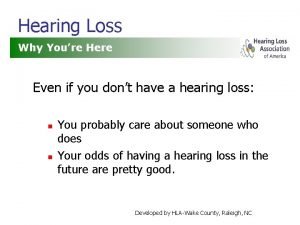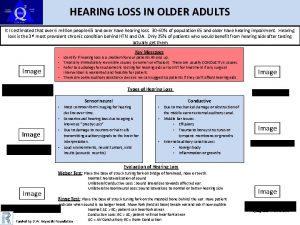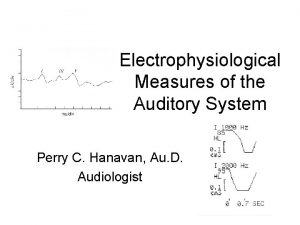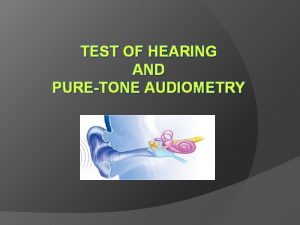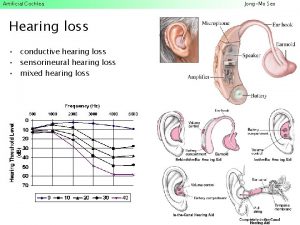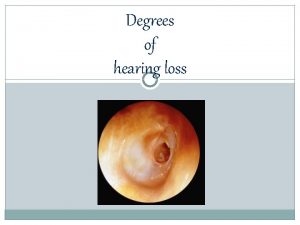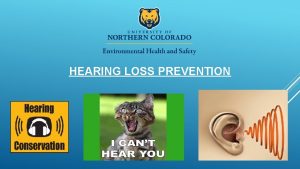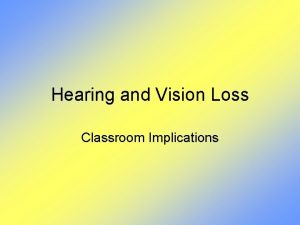SERVING PERSONS WITH HEARING LOSS Classification of Hearing








- Slides: 8

SERVING PERSONS WITH HEARING LOSS

Classification of Hearing Loss Degree of hearing loss Hearing loss range (d. B HL) Normal – 10 to 15 Slight 16 to 25 Mild 26 to 40 Moderate 41 to 55 Moderately severe 56 to 70 Severe 71 to 90 Profound 91+ Source: Clark, J. G. (1981). Uses and abuses of hearing loss classification. Asha, 23, 493– 500.

How can hearing loss be described? • High-frequency versus low-frequency. A person hears either high-pitched or lowpitched sounds better. • Bilateral versus unilateral. Bilateral means hearing loss in both ears. Unilateral means hearing loss in one ear. • Symmetrical versus asymmetrical. Symmetrical means the severity and shape of hearing loss are the same in each ear. Asymmetrical means each ear has a different severity and shape. • Progressive versus sudden hearing loss. Progressive means that hearing loss becomes worse over time. Sudden means hearing loss that happens quickly. Student might not necessarily know that hearing loss has occurred. • Fluctuating versus stable hearing loss. Fluctuating means hearing loss that changes over time. It sometimes gets better, sometimes gets worse. Stable means that your hearing loss has stayed the same. • For more Information go to (https: //www. asha. org/public/hearing/Configuration-of. Hearing-Loss/) (Opens in new window)

How does the type of hearing loss affect accommodations and instruction? • Accommodations need to address the configuration of the hearing loss. • Not every student with a hearing loss uses sign language. • Preferential seating can improve access for students that are hard of hearing and for those using a sign language interpreter. • Not all students with hearing loss know sign language. Some students need alternate formats of instruction such as written instructions. However, a person using ASL needs to have the instructions interpreted into their primary visual language • Always provide written instruction and scripts to students with a hearing loss. • Yelling does not work!!!!! It is embarrassing to the student

Sign Language American Sign Language (ASL) • A visually understood language most commonly used in the US • Has its own unique grammatical and linguistic features • Visually rich – includes facial expressions and gestures • Considered native language for a ‘Child of Deaf Adults’ (CODA) Manually Coded English (MCE) • Uses a sign for each spoken word in the English Language • Lacks conceptual accuracy – lacks meaning

Sign Language Continuum Most Interpreters will thrive to interpreted to the middle of the spectrum

Professional Interpreting Education Interpretation Community Interpretation • K-12 setting or post-secondary setting • • Must have Educational Interpreter Proficiency Assessment (EIPA) Score of 3. 0 (pertains to NC) Interpreting in Vocational, medical, governmental, stage, and judicial settings • Grandfather License – enacted 15 years ago for existing interpreters • For more information go to classroom interpreting. org (opens in new window) • Provisional License – if the Interpreter Training Programs (ITP’s) have been passed • Full Licensure requires a NIC test, offered by the Registry of Interpreters for the Deaf. • For more Information go to https: //rid. org/ and https: //ncitlb. org/

Tips for the Educator who wants to communicate with the Deaf student in their classroom • Attend Continuing Education Classes • Ask your student to teach you one sign every day • Include the interpreter in your classroom planning. Ask for advice on how to make activities more accessible. Your effort will positively affect classroom engagement and learning! Information for this presentation was in part provided by Josee' A. Hupp-Croteau, RID-NIC, CI & CT; Ed: K-12 Owner, Certified ASL/Eng Interpreter
 One person's trash is another person's treasure
One person's trash is another person's treasure Telinga berdengung icd 10
Telinga berdengung icd 10 Cookie bite hearing loss
Cookie bite hearing loss Conductive hearing loss lateralization
Conductive hearing loss lateralization Type c tympanogram hearing loss
Type c tympanogram hearing loss Site:slidetodoc.com
Site:slidetodoc.com Who global estimates on prevalence of hearing loss 2020
Who global estimates on prevalence of hearing loss 2020 Who global estimates on prevalence of hearing loss 2020
Who global estimates on prevalence of hearing loss 2020 Rinne positive
Rinne positive


